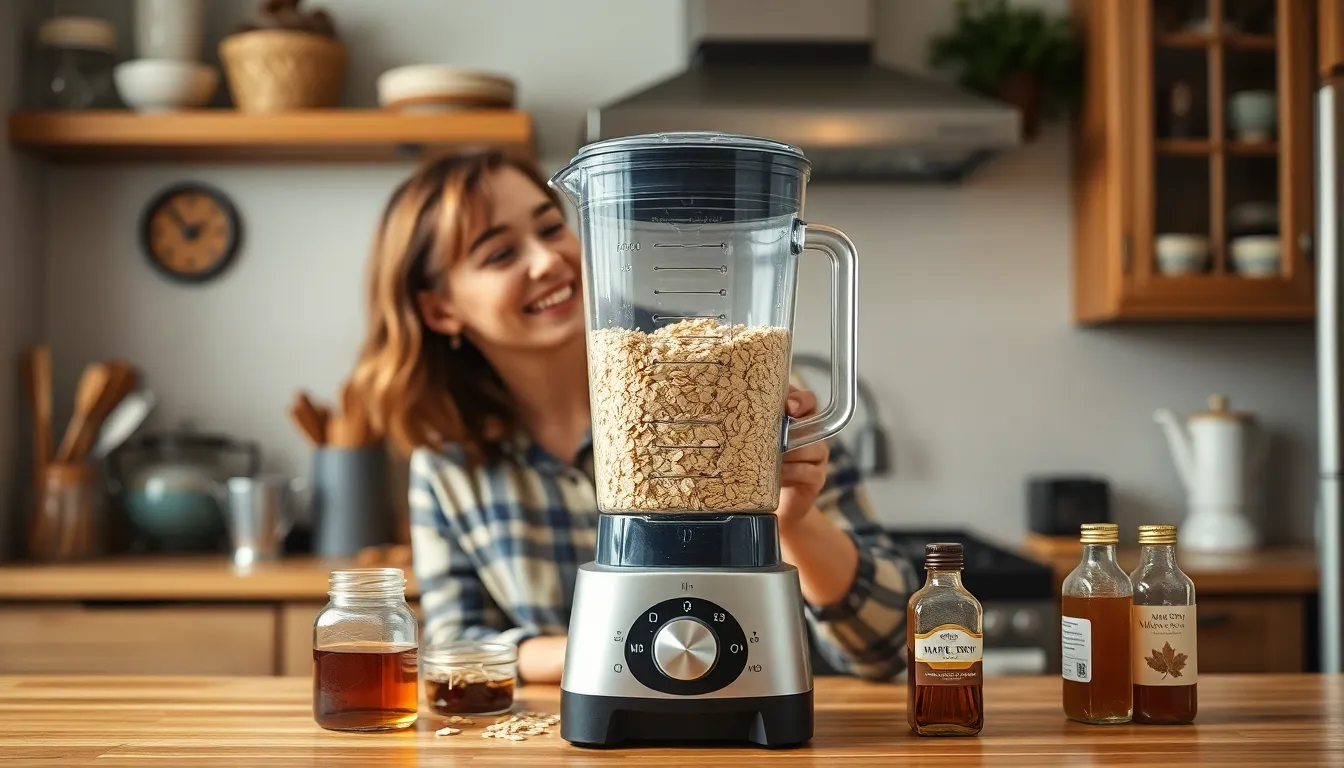Ever wondered why oat milk coffee has become the darling of coffee shops nationwide? This creamy, plant-based alternative has revolutionized how you enjoy your daily caffeine fix, offering a sustainable option that doesn’t compromise on taste or texture.
Oat milk’s naturally sweet flavor profile complements coffee’s bitter notes perfectly, creating a balanced drink that’s both environmentally friendly and delicious. Whether you’re lactose intolerant, vegan, or simply curious about plant-based options, oat milk coffee provides a silky mouthfeel that rivals traditional dairy while aligning with your dietary preferences and values. Let’s explore why this combination has become a staple in modern coffee culture.
What Makes Oat Milk Coffee So Popular
Oat milk coffee has skyrocketed in popularity for several compelling reasons. Its creamy texture creates a luxurious mouthfeel that rivals traditional dairy milk, making each sip a satisfying experience. Many baristas prefer working with oat milk because it steams beautifully and creates microfoam that’s perfect for latte art.
The naturally sweet flavor profile of oat milk complements coffee’s bitter notes without overwhelming them. Coffee enthusiasts often report that oat milk enhances rather than masks the complex flavors of specialty beans. “I’ve noticed customers coming back specifically for our oat milk lattes,” shares Rikki Manny, “they say it brings out chocolate and caramel notes they never tasted before.”
Health considerations drive many coffee drinkers toward this plant-based alternative. Oat milk contains beta-glucans that support heart health and immune function while providing more protein than most non-dairy options. Those with dietary restrictions appreciate that it’s naturally lactose-free, vegan, and often gluten-free when certified.
Environmental consciousness plays a important role in oat milk’s rise to fame. Oats require significantly less water to grow compared to almonds and have a smaller carbon footprint than dairy production. Sustainable coffee shops highlight this eco-friendly aspect to environmentally conscious customers who want to reduce their impact without sacrificing taste.
Versatility adds to oat milk’s appeal in coffee culture. It performs consistently across different brewing methods from espresso-based drinks to cold brew. The neutral yet complementary flavor adapts to seasonal specials, signature drinks, and classic favorites with equal success.
The Nutritional Benefits of Oat Milk in Coffee

Oat milk adds more than just creamy texture to your morning coffee—it brings a range of nutritional advantages. This plant-based alternative offers several health benefits while improving your coffee experience with its naturally sweet flavor profile.
Vitamin and Mineral Content
Oat milk in your coffee provides essential nutrients through fortification. Commercial oat milk brands typically fortify their products with calcium, vitamin D, and vitamin B-12, making them particularly valuable for those following vegan diets. These added nutrients help fill potential nutritional gaps that can occur when eliminating dairy from your diet. Your body receives important bone-supporting minerals and vitamins with each cup of oat milk coffee, contributing to your daily nutritional needs.
Heart-Healthy Properties
The beta-glucan in oat milk makes your coffee choice heart-friendly. This soluble fiber actively helps reduce low-density lipoprotein (bad cholesterol) levels in your bloodstream, supporting cardiovascular health with each sip. Unlike some other coffee additives that might contribute to cholesterol concerns, oat milk actually works to improve your heart health profile. Your morning coffee ritual transforms into a heart-supporting habit when you opt for oat milk.
Nutritional Profile Comparison
Oat milk offers a balanced nutritional profile compared to other milk alternatives. With approximately 17 calories per cup of coffee, 2 grams of carbohydrates, 0.7 grams of fat, and 1 gram of protein, oat milk provides moderate nutritional value. Your coffee gains more protein, fat, and fiber with oat milk than it would with almond milk, though less protein than if you used cow’s milk or soy milk. This middle-ground nutritional position makes oat milk a practical choice for balanced coffee enjoyment.
Texture and Flavor Enhancement
The creamy consistency of oat milk transforms your coffee experience without dairy. Its texture closely mimics cow’s milk, creating luxurious lattes and velvety cold brews that satisfy even traditional dairy drinkers. Your coffee’s flavor profile benefits from oat milk’s subtle sweetness, which complements rather than competes with the coffee’s natural notes. This harmonious pairing explains why specialty coffee shops increasingly offer oat milk as their premium plant-based option.
Environmental Advantages of Choosing Oat Milk
Oat milk stands out as one of the most environmentally responsible choices for your coffee. Producing oat milk requires significantly less water than other milk alternatives and generates a smaller carbon footprint throughout its production cycle. Your daily coffee habit becomes more sustainable when you choose oat milk over conventional dairy or even some other plant-based options like almond milk. Coffee shops worldwide have embraced oat milk not only for its taste and texture but also for its eco-friendly credentials, with many cafes now featuring specialized barista versions designed to froth perfectly in espresso drinks. The mild sweetness of oat milk complements coffee beautifully without overwhelming the flavor, creating an ideal balance that satisfies both environmental concerns and taste preferences.
How Oat Milk Affects Coffee Flavor

Oat milk transforms your coffee experience by adding a subtle sweetness and velvety texture that complements rather than competes with coffee’s natural profile. Its unique composition creates a harmonious balance that has made it increasingly popular among coffee enthusiasts seeking dairy alternatives.
Flavor Enhancement
Oat milk introduces a mild, slightly sweet flavor to your coffee that naturally balances the inherent bitterness of the brew. This sweetness derives from natural sugars released during the oat processing method, creating a pleasant taste without added sweeteners. The creamy consistency of oat milk enhances your coffee’s mouthfeel, delivering a smooth and rich drinking experience comparable to whole milk. Unlike many plant-based alternatives, oat milk maintains a relatively neutral base flavor that preserves your coffee’s original character while amplifying its richness and depth, particularly in espresso-based drinks and traditional brewed coffee.
Texture and Frothability
The natural starches in oat milk create exceptional frothability, making your lattes and cappuccinos visually appealing and texturally satisfying. Barista-grade oat milk produces stable, creamy microfoam that holds its structure long enough for intricate latte art and provides a silky mouthfeel throughout your drinking experience. The consistency closely mimics dairy milk when steamed, creating tiny bubbles that integrate seamlessly with espresso rather than separating or breaking down quickly. This texture enhancement makes oat milk particularly valuable for specialty coffee drinks where proper foam structure significantly impacts both presentation and taste.
Comparing Oat Milk to Other Non-Dairy Alternatives
Oat milk offers a more balanced flavor profile compared to alternatives like almond milk with its pronounced nuttiness or coconut milk with its distinctive tropical notes. These stronger flavor signatures can sometimes clash with delicate coffee characteristics, while oat milk serves as a complementary canvas. Texture-wise, oat milk provides superior creaminess and body compared to thinner alternatives such as rice or almond milk, creating a more satisfying coffee experience that closely resembles traditional dairy drinks.
The environmental credentials of oat milk surpass many alternatives, with its production requiring significantly less water than almond milk and generating fewer greenhouse gases than dairy. This sustainability aspect has made it particularly attractive to environmentally conscious coffee shops and consumers. Oat milk demonstrates remarkable versatility across different coffee origins and processing methods, improving rather than masking the unique flavor notes of specialty coffees from fruity East African varieties to chocolate-forward Latin American beans.
Its neutral starting point allows the distinct characteristics of your coffee to shine through while providing body and sweetness that elevates the overall drinking experience. This adaptability explains why both professional baristas and home coffee enthusiasts increasingly reach for oat milk as their preferred dairy alternative for everything from morning lattes to afternoon cold brews.
Best Coffee Drinks to Make with Oat Milk

Oat milk coffee drinks offer a creamy, slightly sweet alternative to traditional dairy options. They’re particularly appealing for their rich texture and complementary flavor profile that enhances coffee’s natural characteristics.
Oat Milk Lattes and Cappuccinos
Oat milk lattes combine strong coffee or espresso with steamed oat milk to create a velvety, indulgent beverage. Creating this classic drink at home requires approximately 1.5 cups of oat milk and either half a cup of strong brewed coffee or two espresso shots. Many coffee enthusiasts enhance their lattes with vanilla essence or natural sweeteners like honey or maple syrup, which accentuate oat milk’s inherent sweetness while balancing coffee’s bitterness.
Cappuccinos made with oat milk feature equal parts steamed milk and foam atop espresso, resulting in a frothier texture than lattes. Adding warming spices such as cinnamon or nutmeg creates delightful variations like cinnamon oat milk cappuccinos that offer seasonal flair without dairy.
Several flavored variations have gained popularity, including honey oat milk lattes and cinnamon honey oat milk lattes that blend oat milk with honey, cinnamon, and a pinch of salt. Vanilla oat milk lattes incorporate vanilla extract or vanilla-flavored oat milk, while mocha versions use chocolate-flavored oat milk for a decadent treat.
For those without an espresso machine, oat milk lattes remain accessible—simply brew strong coffee, warm oat milk with your preferred sweeteners and spices, then froth or shake until foamy before combining the elements.
Cold Brew with Oat Milk
Cold brew coffee pairs exceptionally well with oat milk, creating refreshing, smooth beverages perfect for warmer weather. This combination works beautifully as an iced drink—pour cold brew concentrate over ice cubes and top with chilled oat milk and foam for a creamy, refreshing experience without dairy.
Quick oat milk coffee drinks require just four ingredients: coffee, oat milk, brown sugar, and maple syrup, ready in under 5 minutes for busy mornings. Leftover oat milk lattes maintain their quality when stored in the refrigerator for up to three days and can be gently reheated without losing their characteristic creaminess.
Oat milk’s superior frothability makes it ideal for both hot and cold coffee preparations, setting it apart from other plant-based alternatives. Its naturally sweet flavor profile complements coffee’s complexity while adding a silky mouthfeel that’s become increasingly favored by both professional baristas and home coffee enthusiasts.
Tips for Frothing Oat Milk Perfectly

1. Start with the Right Temperature
Optimal temperature control makes all the difference when frothing oat milk. Heat your oat milk to 60-65°C (140-149°F) for the best results. Temperatures exceeding this range cause the milk to develop a dry, overly foamy texture rather than the silky smoothness you’re after in specialty coffee drinks.
2. Introduce Air Slowly (Aeration)
Proper aeration techniques create the foundation for excellent oat milk foam. Position your steam wand tip just below the milk’s surface to introduce tiny rips of air during the initial steaming phase. Oat milk requires slightly more aeration than dairy milk due to its lower protein content, which compensates for its reduced natural frothing ability.
3. Create a Vortex to Break Down Bubbles
Developing a consistent vortex transforms ordinary foam into velvety microfoam. After initial aeration, lower the steam wand deeper and lift the pitcher slightly to create a spinning motion that breaks large bubbles into microfoam. Listen for a quieter sound from the wand—this indicates you’re in the ideal “quiet zone” necessary for fine microfoam development. Loud hissing or popping sounds signal improper wand placement.
4. Use a Gentle Steaming Technique
Gentle pressure control ensures superior oat milk texture. Maintain moderate steam pressure, especially toward the end of the steaming process. This approach prevents larger bubbles from forming and preserves the smooth consistency needed for latte art and premium mouthfeel.
5. Let the Milk Sit Briefly
Patience rewards you with better texture after steaming. Allow your freshly steamed oat milk to rest for 15-20 seconds before pouring. This brief resting period lets the foam settle and thicken on top, significantly improving both texture and pourability for creating intricate latte art designs.
Alternative Frothing Method: Manual Frother
Manual frothers offer excellent results without expensive equipment. Warm your oat milk gently in a microwave or on a stovetop, then transfer it to a glass manual frother. Pumping approximately 20 times produces thick, rich froth suitable for your favorite coffee drinks. This method provides a practical solution for creating quality oat milk foam at home without professional equipment.
Top Oat Milk Brands for Coffee

Minor Figures
Minor Figures stands out as a premium choice for coffee enthusiasts, originating from a London microbrewery with a exact focus on coffee applications. This brand produces ultra fluffy, substantial foam that firms up perfectly for cappuccinos and other foam-topped beverages. Its balanced profile offers moderate sweetness, medium thickness, and a creamy flavor with a refreshing aftertaste. Many baristas appreciate its bright oat flavor and slight saltiness, making it versatile enough for coffee drinks, smoothies, and plain drinking.
Oatly
Oatly has earned its reputation as one of the most recognized oat milk brands, even securing a partnership with Starbucks for their coffee drinks. The original formula provides a full-bodied creaminess with subtle hints of vanilla and nuttiness that complement coffee beautifully. Oatly’s Barista Edition takes these qualities further with a rich, smooth texture and slightly sweet flavor profile. Coffee lovers particularly enjoy how Oatly enhances their cold brews and lattes without overwhelming the coffee’s natural characteristics. The thick, consistent foam makes it perfect for creating latte art in espresso-based beverages.
Trader Joe’s Non-Dairy Oat Beverage
Trader Joe’s offers a compelling option for those who prefer a more pronounced oat flavor in their coffee. This oat milk features a creamy texture with concentrated oat flavor and earthy undertones that add depth to coffee drinks. Its relatively thick consistency holds up well in hot beverages, providing a satisfying mouthfeel comparable to whole dairy milk. For optimal results, keep this oat milk refrigerated before adding it to your coffee.
Other Notable Brands
Several other brands deserve mention for their unique qualities when paired with coffee. Califia Farms and Chobani provide excellent alternatives for those who prefer a more subtle oat presence, allowing the coffee’s flavor notes to take center stage. Vermondo Oat Barista, available at Lidl, offers a creamy texture that performs well in both coffee and breakfast applications. Additional options include Mooala, Planet Oat, Friendly Farms, Good & Gather, Pacific Foods Barista Series, Silk, and 365, though these generally rank lower in comparative tastings.
Your choice of oat milk significantly impacts your coffee experience, with each brand offering distinct characteristics. Those seeking exceptional foam quality might prefer Minor Figures, while coffee drinkers wanting a creamier, richer flavor profile often gravitate toward Oatly’s Barista Edition. Trader Joe’s appeals to those who enjoy a more prominent oat flavor, and brands like Califia Farms work well for subtle background notes that let specialty coffee flavors shine through.
Making Your Own Oat Milk at Home

Homemade oat milk offers a simple, cost-effective alternative to store-bought varieties with just a few basic ingredients and minimal equipment. Creating your own oat milk gives you complete control over sweetness levels and texture, allowing you to customize it perfectly for your coffee drinks.
Basic Ingredients
- Rolled oats (½ to 1 cup)
- Filtered cold water (3 to 6 cups)
- Optional flavorings (maple syrup, vanilla extract, sea salt, or sweeteners)
Preparation Steps
- Blend: Combine oats and cold water in a blender with any optional ingredients like maple syrup or vanilla extract. Blend on high for approximately 30 seconds—blending longer can create a slimy texture.
- Strain: Pour the blended mixture through a fine mesh strainer, cheesecloth, or nut milk bag into a bowl. Avoid pressing or squeezing the mixture to prevent a gummy consistency.
- Repeat: Strain a second time to remove additional pulp, resulting in a smoother, creamier milk texture.
- Chill: Refrigerate the oat milk overnight for optimal flavor development. Remember to shake well before using since homemade versions naturally separate.
- Storage: Keep your fresh oat milk in an airtight container in the refrigerator for 4-5 days.
Tips to Avoid Slimy Texture
Using cold water helps limit starch release during the blending process. Keeping your blend time brief—no more than 30-40 seconds—prevents the oats from breaking down too much. During straining, resist the urge to press down on the oat pulp, as this can force starches through the strainer and create an unpleasant texture.
Sample Recipe
| Ingredient | Amount |
|---|---|
| Rolled oats | ½ cup |
| Water | 3 cups |
| Maple syrup | 2 tsp |
| Vanilla extract | ½ tsp |
| Sea salt | ⅛ tsp |
This recipe from Love and Lemons produces a lightly sweetened oat milk that pairs exceptionally well with coffee. The natural sweetness and creamy texture complement coffee’s inherent bitterness while maintaining a neutral enough flavor profile to let your coffee shine through.
Your homemade oat milk creates a rich, velvety mouthfeel in coffee drinks and froths beautifully for lattes and cappuccinos. The subtle oat flavor enhances rather than overpowers your brew, making it an excellent dairy-free option for your morning coffee ritual.
Conclusion
Oat milk coffee has revolutionized the coffee scene with its perfect balance of creamy texture and sustainable benefits. You’ll find its naturally sweet profile enhances your favorite brew while aligning with health-conscious and eco-friendly values.
Whether you’re exploring professional barista-crafted drinks or perfecting your home brewing techniques the versatility of oat milk shines across lattes cappuccinos and cold brews. From store-bought options like Minor Figures and Oatly to homemade alternatives you have many ways to incorporate this plant-based milk into your coffee routine.
As you experiment with different brands frothing techniques and recipes you’ll discover why oat milk has earned its place as the preferred dairy alternative in coffee shops worldwide. Your coffee experience will be richer more sustainable and deliciously satisfying.
Frequently Asked Questions
What is oat milk coffee?
Oat milk coffee is a beverage that combines coffee with oat milk, a plant-based alternative to dairy milk. It has gained popularity for its creamy texture, naturally sweet flavor, and ability to enhance coffee’s taste profile. This dairy-free option appeals to those who are lactose intolerant, vegan, or interested in sustainable alternatives while still providing a rich, satisfying coffee experience.
Why is oat milk becoming popular in coffee shops?
Oat milk’s popularity stems from its luxurious mouthfeel that rivals dairy, excellent frothability for latte art, and ability to enhance coffee flavors. It’s naturally lactose-free and vegan, containing beneficial beta-glucans for heart health. Environmental benefits are significant too—oat milk requires less water and has a smaller carbon footprint than dairy. Its versatility across brewing methods makes it a favorite for both seasonal specials and classic drinks.
How does oat milk affect coffee flavor?
Oat milk introduces a subtle sweetness that naturally balances coffee’s bitterness while adding a velvety texture. Unlike stronger-flavored alternatives like coconut or almond milk, oat milk has a neutral profile that complements rather than competes with coffee’s natural characteristics. Its creaminess enhances the coffee experience without masking the complex flavors of specialty beans, making it a preferred choice among coffee enthusiasts.
What nutritional benefits does oat milk offer in coffee?
Oat milk is typically fortified with essential nutrients like calcium, vitamin D, and B-12, particularly beneficial for vegans. It contains beta-glucan, a soluble fiber that helps reduce cholesterol levels and supports heart health. With a moderate calorie and nutrient profile compared to other alternatives, oat milk provides a balanced option that delivers creaminess without excessive fat or sugar, making it a nutritious addition to your daily coffee.
What are popular oat milk coffee drinks?
Popular oat milk coffee drinks include oat milk lattes, which combine espresso with steamed oat milk for a creamy texture, and cappuccinos featuring equal parts milk and foam. Variations like honey oat milk lattes add natural sweetness, while mocha versions incorporate chocolate. Cold brew with oat milk offers a refreshing iced option. These drinks showcase oat milk’s superior frothability and naturally sweet profile, making them favorites at coffee shops worldwide.
How do you froth oat milk perfectly?
For perfect oat milk froth, control temperature (130-150°F is ideal) and create a vortex while steaming to break down large bubbles. Use gentle aeration techniques at the beginning, then submerge the steam wand deeper to create microfoam. Allow the milk to rest briefly after steaming to improve texture. Without professional equipment, a manual frother can achieve good results. Barista-formulated oat milks generally froth better than regular versions.
Which oat milk brands work best for coffee?
Top brands for coffee include Minor Figures (excellent foam, premium quality), Oatly (creamy texture, Starbucks’ choice), and Trader Joe’s Non-Dairy Oat Beverage (richer oat flavor). Califia Farms and Chobani offer subtle profiles that let coffee flavors shine. Barista editions specifically formulated for coffee typically perform better than regular versions, creating smoother microfoam and integrating better with coffee’s acidity and oils.
Can I make oat milk at home for coffee?
Yes, homemade oat milk is simple and cost-effective. Blend 1 cup rolled oats with 4 cups filtered water for 30-45 seconds, strain through a fine mesh cloth or nut milk bag, and avoid over-blending to prevent sliminess. For coffee use, adding a teaspoon of neutral oil improves frothability and a pinch of salt enhances flavor. Homemade versions typically last 3-5 days refrigerated and provide a fresh alternative to store-bought options.
Is oat milk coffee environmentally friendly?
Yes, oat milk coffee is significantly more environmentally friendly than dairy alternatives. Oat production requires about 13 times less water than dairy milk and generates fewer greenhouse gas emissions. Oats are also relatively low-impact crops that can be grown in various climates without extensive resources. For eco-conscious coffee drinkers, choosing oat milk represents a sustainable choice that reduces environmental impact while still providing a satisfying coffee experience.
How does oat milk compare to other non-dairy alternatives for coffee?
Oat milk outperforms most non-dairy alternatives in coffee applications due to its neutral flavor, superior creaminess, and exceptional frothability. Unlike almond milk (which can separate) or coconut milk (which has a distinct flavor), oat milk integrates seamlessly with coffee. It has a balanced fat content that creates stable microfoam for latte art and doesn’t curdle in hot or acidic coffee. This versatility makes it the preferred choice for many baristas.


























